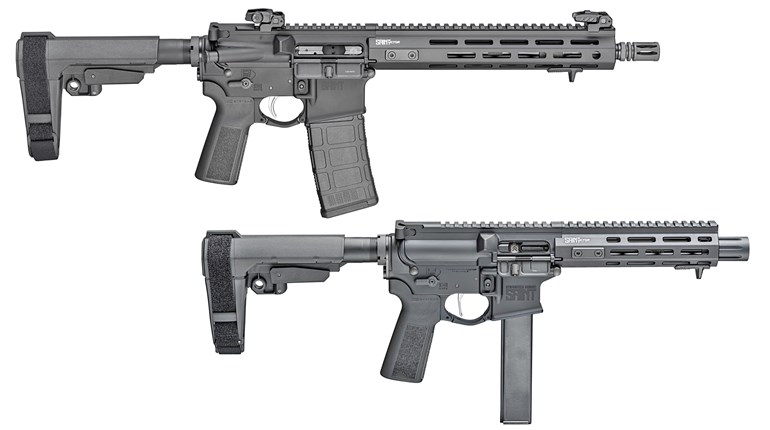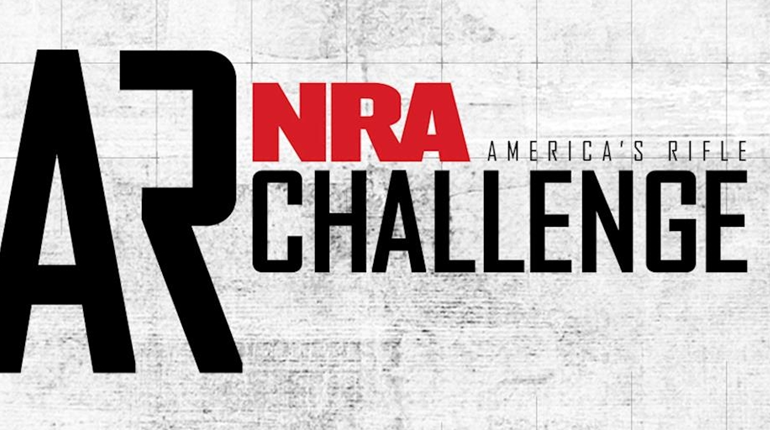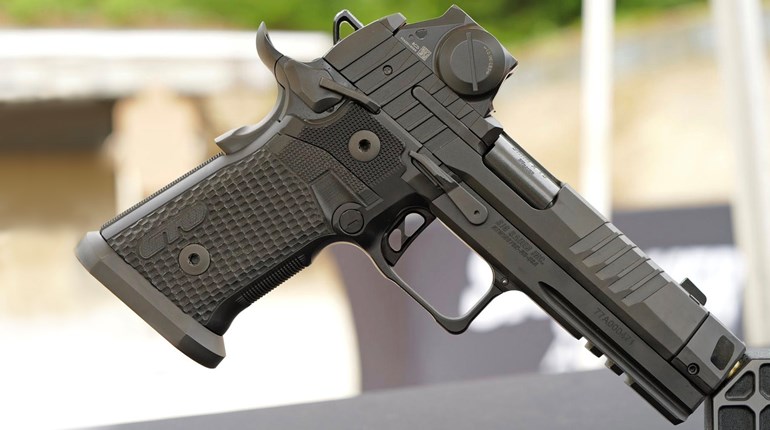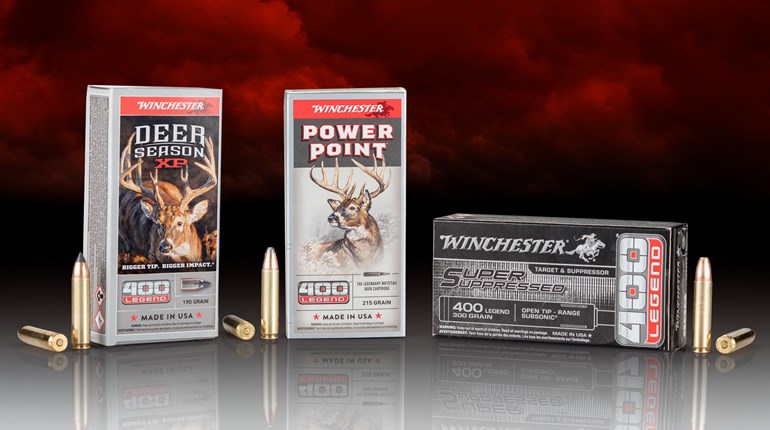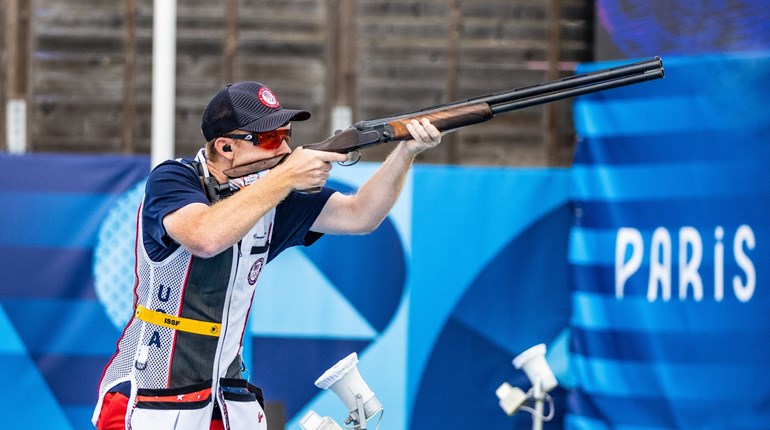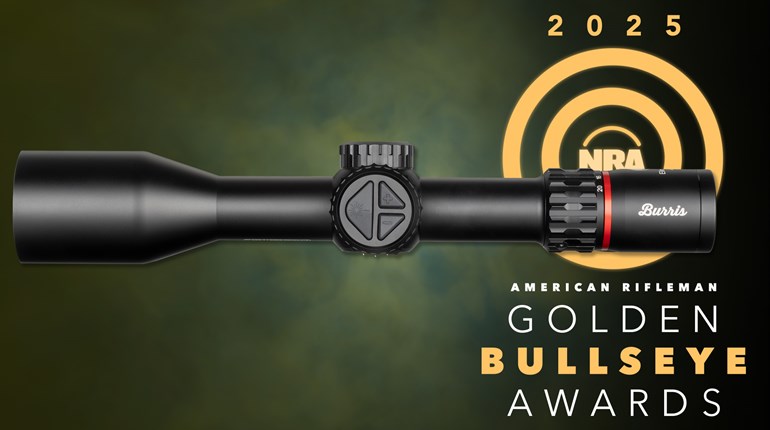
In the world of AR-15 clones, there are relatively few that will turn heads, but when they do, it is usually due to one of two things: a new AR model from a respected manufacturer or something the likes of which had never been seen before. One of the latter is the subject at hand.
Designed by Robert Faxon, of Faxon Firearms in Ohio, the new rifle is called the ARAK-21 (for 21st century). It is only a small part of the company, which has for years been a large military armament contractor. The ARAK-21, however, is a product for which the company will become synonymous with in the field of small arms.

When Bob Faxon showed me prototypes of the ARAK at the 2014 SHOT Show, he told me the rifle combined features of the AR-15 and the AK-47. Upon examination, however, I told him I was seeing more “Stoner” than AK-47 in his rifle. Faxon said, “You’re right, but few people these days know what a Stoner is.” Sadly, he was right, as what was arguably the most-advanced small-arms system in the world 50 years ago is largely forgotten today.
Aside from a slight AK silhouette at the rear of the upper receiver, the ARAK -21 resembles more the AR and the SCAR. Although the ARAK came with a standard AR six-position retractable BCM stock and tube, it would surely accept one of the aftermarket collapsible stocks. What’s more, the upper-receiver group can interface with a Mil-Std AR lower with all lower-receiver parts being the same, but that’s where things start to change.

Although the entire upper-receiver group is of robust billet aluminum, while the Stoner’s was of pressed steel, both are monolithic and quite unique. The ARAK-21 also has a top rail running full-length. Sandwiched between the fore and aft upper and lower handguard sections is Faxon’s revolutionary, almost quick-change barrel, which differs from any other.
Like the AK-47 and the Stoner, the ARAK-21 operates by a long-stroke gas piston connected to the rectangular bolt carrier. Also like the Stoner (but not the AK), the ARAK has an adjustable gas block, and an ambidextrous, non-reciprocating cocking handle, which folds forward out of the way. A long-coil recoil spring is retained in the upper receiver and, when field-stripped, the ARAK’s similarities to the Stoner and AK-47 become apparent.
Elementary Disassembly
While wearing protection, pointing the rifle in a “safe” direction and making sure the ARAK is empty with the bolt forward and the safety ON, push out the AR-type locking pins in the lower receiver and separate it from the upper receiver group. Then push out the smaller pin at the upper rear of the upper receiver to unlock the recoil plate (“lug”).

Noting that the recoil plate is under recoil-spring pressure, push the plate in and down, unlocking it to allow the recoil spring to extend out the rear, and remove it. With the recoil spring removed, tilt the barrel up to allow the bolt group to slide back, catch it and remove it from the rear.
You will note that the ARAK’s bolt carrier resembles those of the AR-18, H&K G36, FN SCAR, ACR and yes, the Stoner 63/63A, but that it rides on steel rails semi-permanently installed in both sides of the receiver. The ARAK’s bolt mirrors those of the above rifles along with the M16 and disassembles much like them, but has eight strong, radiused locking lugs and dual ejectors. The even number of lugs allows for the bolt to be rotated 180 degrees, but more on this below.

Semi-permanently attached to the bolt carrier is a 9.75-inch, long-stroke gas piston similar to those of the AK-47 and Stoner 63/63A rifles. This piston rides in a gas cylinder connected to a five-position gas block that is rotated using a cartridge. Clockwise positions are remove, low, medium, high and no gas with .300 BLK having no medium position.
In the monolithic fore-end/handguard are 12 cooling vents in the top and 10 in the removable bottom part, which is connected by six large hex bolts in heli-coils. With the bolts removed, the lower handguard is free from locking the barrel and trunnion in place and the barrel can be removed forward and straight down from the upper- receiver group (with the bolt removed), a process taking about one minute and uses a standard Allen wrench.
The fit of the ARAK-21’s barrel to its monolithic receiver can only be described as hyper precision, and the subsequent rigidity is far and away superior to that of the AK-47 with the “bullwhip” flip-flop of the latter’s barrel group and handguard when fired. The resulting sure bedding of the ARAK-21’s barrel at both ends is automatic when assembled.

The ARAK-21’s 6-groove; 1:8-inch RH-twist barrel can be replaced with one of shorter or longer length, and/or different configuration or caliber in stainless steel or black nitride. A spare barrel, bolt and magazines in 7.62x39 mm were furnished with the sample 5.56 NATO ARAK rifle and barrels in .300 BLK are also available, with 6.5 Grendel, 5.45x39 mm and 6.8 Rem. SPC to follow in addition to selective-fire versions.
Especially interesting is that the 7.62x39 mm bolt is not made by modifying a standard 5.56 NATO bolt. Instead, the portion of the bolt forward of the carrier is made larger from the start to house a larger bolt face, firing pin and larger lugs. The trunnion and feed ramps have also been redesigned just for this cartridge to insure reliability and strength.

All standard ARAK barrels use a proprietary taper to reduce weight. They also come with a 5⁄8-24 muzzle thread with a unique and effective muzzle brake locked in place by a reverse nut, similar to Savage’s barrel installation. Removal of the brake will allow use of a sound suppressor with appropriate adjustment of the gas system. Now back to that eight-lug bolt.
Unique among AR-style rifles has been the dual ejection port design of the Beretta AR16/160 rifle, but now add the ARAK-21. Offered with an open ejection port and a case deflector on both sides, the ARAK can be changed from right to left ejection by simply removing and rotating the bolt 180 degrees and putting it back together. The folding cocking handle can also be reversed, but there’s more.

As with the Beretta, the ARAK-21 allows either a right- or left-handed user to easily see or check (in the dark) the breech for malfunctions, bolt hold-open, etc. without having to rotate the weapon. An advantage? I think so.
Our early sample ARAK-21 came without any accessories, except for the requested 7.62x39 mm barrel, bolt and the company’s new 7.62x39 mm magazines. I think this is a good idea, as slings, sights and other add-ons are personal preferences and when furnished with a gun they often end up in a box on the floor.
To match the FDE color of the sample, I added a set of Magpul MBUS, a Blue Force Gear Victory Sling and Manta Rail suppressor covers to the rifle in the same color. For accuracy tests I used a Leupold MK IV 3-10x30 mm Sniper Scope in FDE. I found the issue black Hogue Grip and BCM stock more than satisfactory, so left them alone, but I would replace, or paint them to match the rifle.
Another valuable accessory is LaserMax’s tiny Micro Laser, which can be mounted on the top rail in front of the front sight to provide a powerful red or green pulsing laser right above the rifle’s bore.

Downrange
For shooting the ARAK-21 offhand we mounted an FDE EoTech Model 553 with an A.R.M.S. ThrowLever mount. Here, the ARAK-21 revealed the efficiency of its simple factory muzzle brake, which keeps the muzzle on target, allowing fast hits on silhouettes at 100 yards. The dual ejection ports made verification a cinch in any light and the forward cocking handle proved to be handy with all other functions working normally.
With the muzzle brake replaced by a Gemtech TREK-T Titanium suppressor and Manta Cover, felt recoil was about the same and the slight weight increase was hardly noticed. Adjusting the gas block was also easy and the block was set on the smallest port. Mounting the Leupold MK IV scope to the ARAK-21 produced five-shot groups of .92-inch to 2.64-inches from the bench using commercial .223 Rem. and M855 surplus ammunition with no malfunctions.
However, as with AR-type rifles (but not the AK) when used with a suppressor, residual gas did exit from the rear of the upper receiver around the recoil lug. Thus, the ARAK-21’s gas is best set on the “off” position relegating it to a repeater when using a suppressor, something neither the AK nor the standard AR platform can do.

The ARAK-21 in 7.62x39 mm
Removing the lower handguard and replacing the barrel, bolt group and recoil spring took about four minutes using only the hex wrench furnished. To test the 7.62x39 mm ARAK-21 we again used the EoTech 553. The Faxon muzzle brake cut felt recoil, allowing fast off-hand hits, as before. Replacing the muzzle brake with a Gemtech 7.62 mm Titanium Sandstorm suppressor allowed recoil to increase, but not by much, and noise was less than using .308 Win. With this suppressor we set the gas in the “off” position, cocking the rifle each time with the left hand.
With the Leupold MK IV Scope mounted, five-shot benchrest groups at 100 yards ran from 1.68 inches to 2.73 inches using both commercial and military-surplus 7.62x39 mm ammunition. The special magazines used included C-Products (furnished with the rifle) and D&H Tactical, and no malfunctions occurred. While there was some “play” between the upper and lower receivers, it did not seem to matter, as four of the hits measured .93-inch with a flier opening up that group to 2.28 inches. A match trigger of choice would certainly improve hits.
The Stoner 63 has been largely forgotten for one reason; it was never sold commercially, and Robinson Armament’s M96 rifle based on it had a relatively short run. The ARAK-21, however, is here to stay, and it contains so many advanced features that it could have been called the “StonAR.”














